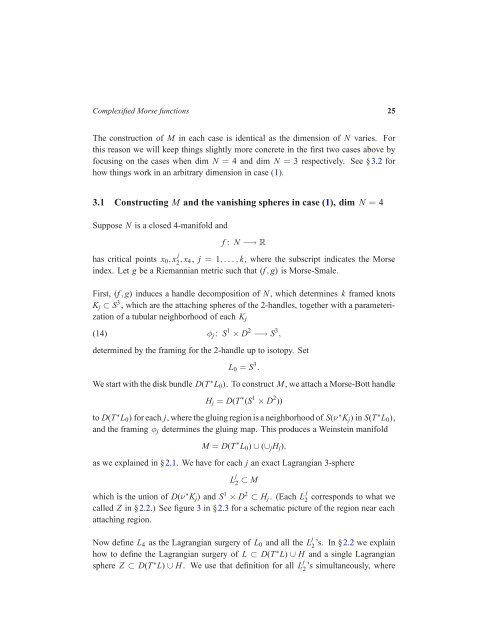The Picard-Lefschetz theory of complexified Morse functions 1 ...
The Picard-Lefschetz theory of complexified Morse functions 1 ...
The Picard-Lefschetz theory of complexified Morse functions 1 ...
Create successful ePaper yourself
Turn your PDF publications into a flip-book with our unique Google optimized e-Paper software.
Complexified <strong>Morse</strong> <strong>functions</strong> 25<br />
<strong>The</strong> construction <strong>of</strong> M in each case is identical as the dimension <strong>of</strong> N varies. For<br />
this reason we will keep things slightly more concrete in the first two cases above by<br />
focusing on the cases when dim N = 4 and dim N = 3 respectively. See §3.2 for<br />
how things work in an arbitrary dimension in case (1).<br />
3.1 Constructing M and the vanishing spheres in case (1), dim N = 4<br />
Suppose N is a closed 4-manifold and<br />
f : N −→ R<br />
has critical points x0, x j<br />
2 , x4, j = 1,... , k, where the subscript indicates the <strong>Morse</strong><br />
index. Let g be a Riemannian metric such that (f, g) is <strong>Morse</strong>-Smale.<br />
First, (f, g) induces a handle decomposition <strong>of</strong> N , which determines k framed knots<br />
Kj ⊂ S 3 , which are the attaching spheres <strong>of</strong> the 2-handles, together with a parameterization<br />
<strong>of</strong> a tubular neighborhood <strong>of</strong> each Kj<br />
(14)<br />
φj : S 1 × D 2 −→ S 3 ,<br />
determined by the framing for the 2-handle up to isotopy. Set<br />
L0 = S 3 .<br />
We start with the disk bundle D(T ∗ L0). To construct M, we attach a <strong>Morse</strong>-Bott handle<br />
Hj = D(T ∗ (S 1 × D 2 ))<br />
to D(T ∗ L0) for each j, where the gluing region is a neighborhood <strong>of</strong> S(ν ∗ Kj) in S(T ∗ L0),<br />
and the framing φj determines the gluing map. This produces a Weinstein manifold<br />
M = D(T ∗ L0) ∪ (∪jHj),<br />
as we explained in §2.1. We have for each j an exact Lagrangian 3-sphere<br />
L j<br />
2 ⊂ M<br />
which is the union <strong>of</strong> D(ν∗Kj) and S1 × D2 ⊂ Hj. (Each L j<br />
2 corresponds to what we<br />
called Z in §2.2.) See figure 3 in §2.3 for a schematic picture <strong>of</strong> the region near each<br />
attaching region.<br />
Now define L4 as the Lagrangian surgery <strong>of</strong> L0 and all the L j<br />
2 ’s. In §2.2 we explain<br />
how to define the Lagrangian surgery <strong>of</strong> L ⊂ D(T∗L) ∪ H and a single Lagrangian<br />
’s simultaneously, where<br />
sphere Z ⊂ D(T ∗ L) ∪ H. We use that definition for all L j<br />
2
















